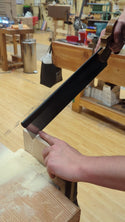Current lead time: about 6-10 weeks for most configurations. Call or email info@badaxetoolworks.com for more accurate lead times.
Specs:
- 14 ppi (Pitch per Inch)
- Recommended Filing - Hybrid
- Plate Thickness .018"
- Kerf of .027"
- Depth of cut 2 1/16"
- Perfect for building furniture, cabinets, and general joinery. Great for cutting tenons, dados, and long sliding dovetails.
Introducing the Bad Axe Bayonet, a powerful and precise tool designed to handle a wide range of carcass joinery tasks with ease. Measuring 14 inches in length and featuring a finely filed 14 PPI tooth configuration on a thin .018-gauge plate, this saw is built to tackle even the most demanding cuts with confidence.
The Bayonet excels at slicing tenon shoulders of all sizes, executing long-span miter cuts, sawing dadoes, cutting rabbets, and crafting sliding dovetail pins and tails with precision. Its exceptional balance, minimal stroke efficiency, and unmatched accuracy make it a trusted companion for fine joinery work.
Unleash the full potential of your craftsmanship with the Bad Axe Bayonet where precision meets power, and every cut is executed with effortless control.
For centuries, cold steel has shaped the course of history. From Chamberlain’s charge at Little Round Top to the siege of Rorke’s Drift and the brutal trenches of Ypres, the infantryman’s bayonet was more than a weapon, it was a statement of resolve. Nothing sent fear through an enemy’s ranks quite like the sight of a charging soldier with steel bared and an unrelenting purpose. The Bad Axe Bayonet embodies that same relentless sharp, decisiveness, built to get the job done.
_____________________________________________________________________________________________



























